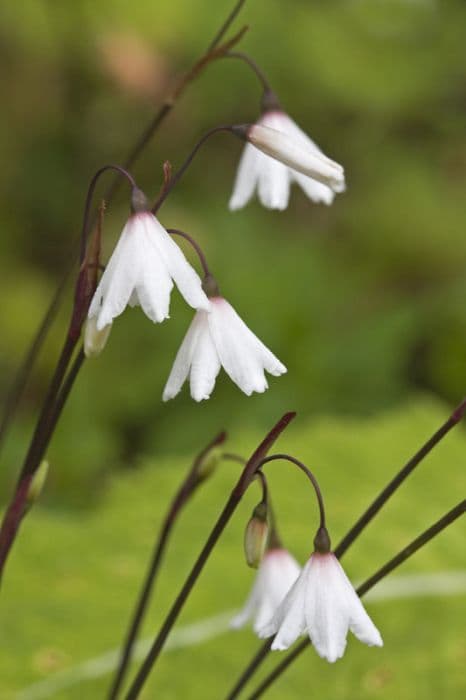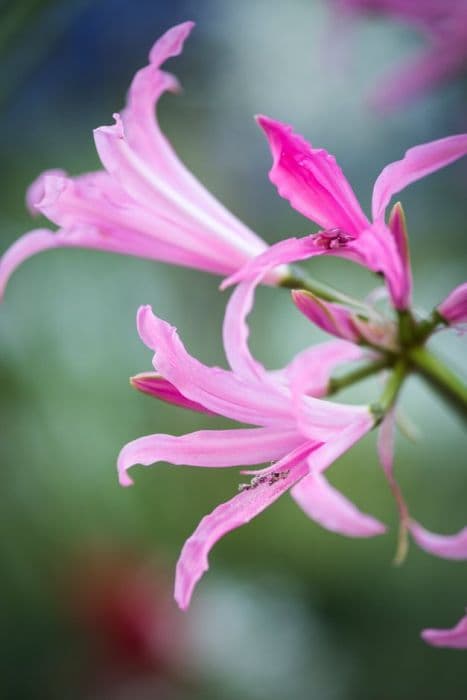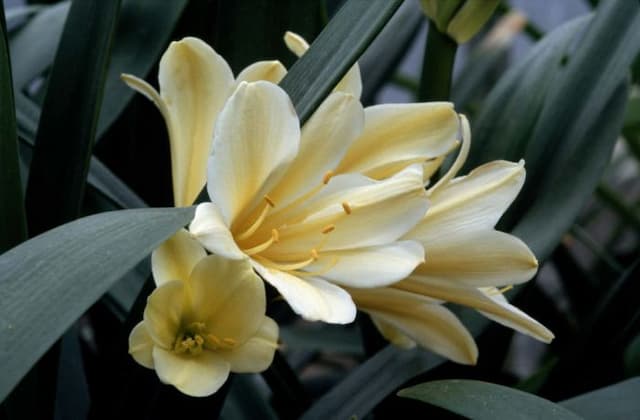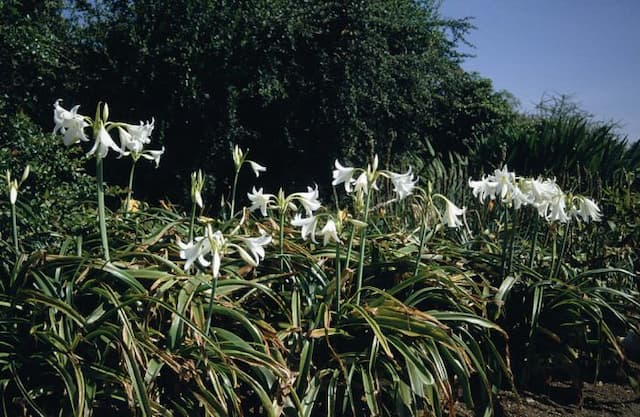Daffodil Narcissus 'Menehay' (11a)

ABOUT
The Narcissus 'Menehay', commonly known as a type of daffodil, is an ornamental flower boasting a striking appearance characteristic of its genus. The plant has a central trumpet-shaped corona surrounded by a ring of six petal-like tepals. The corona is often a vibrant, contrasting color to the tepals, sometimes displaying a richer or different hue which sets off the beauty of the bloom. The tepals are typically elongated and may have a slight back sweep from the center, creating an elegant and graceful form. The foliage of the daffodil 'Menehay' includes slender, sword-shaped leaves that are a lush, deep green. These leaves grow from the base of the plant, forming a neat cluster that complements the flowers. The daffodil blooms are known for their bright and cheerful colors, which can range from various shades of yellows and whites to more complex colors involving pinks and oranges. Some may have a combination of colors, with the petal edges or the trumpet accented with a different shade. The overall impression of the Narcissus 'Menehay' is one of delicate beauty and vibrant cheer, which is why these plants are widely appreciated for their springtime display in gardens and as cut flowers in arrangements. Their appearance can signify the end of the winter season and the beginning of a more lively and colorful time of the year.
About this plant
 Names
NamesFamily
Amaryllidaceae
Synonyms
Daffodil, Jonquil, Narcissus
Common names
Narcissus 'Menehay'.
 Toxicity
ToxicityTo humans
The common name for Narcissus 'Menehay' is daffodil. Daffodils are poisonous to humans if ingested. They contain alkaloids such as lycorine and others, which can cause symptoms such as nausea, vomiting, diarrhea, and abdominal pain. In severe cases, ingestion can lead to dehydration, cardiac arrhythmias, and central nervous system issues. Handling the plant or its bulbs can also cause skin irritation in some individuals.
To pets
For pets, daffodils are also toxic. If ingested, they can cause similar symptoms to those in humans, including vomiting, diarrhea, abdominal pain, trembling, salivation, and cardiac arrhythmias. Severe poisoning can be fatal, especially if treatment is not sought promptly after ingestion. It's crucial to keep daffodils out of reach of pets to avoid accidental poisoning.
 Characteristics
CharacteristicsLife cycle
Perennials
Foliage type
Deciduous
Color of leaves
Green
Flower color
Yellow
Height
1-1.5 feet (30-45 cm)
Spread
0.5 feet (15 cm)
Plant type
Bulb
Hardiness zones
4-9
Native area
Europe
Benefits
 General Benefits
General Benefits- Attracts Pollinators: The Narcissus 'Menehay', also known as Daffodil, is known to attract bees and other pollinating insects, which is beneficial for garden biodiversity.
- Low Maintenance: Daffodils require minimal care once established; they are tolerant of a range of soil conditions and can thrive with minimal watering.
- Spring Blooms: As a spring-flowering bulb, they provide early color to gardens after winter, often blooming when few other plants do.
- Perennial Growth: Daffodils are perennials that return year after year, and they can naturalize, or spread, over time to cover more space.
- Deer and Rodent Resistant: Daffodils are not preferred by deer or rodents, making them an excellent choice for areas where these animals are a concern.
- Cut Flowers: Daffodils can be cut and will last well in vases, providing a fresh option for indoor decoration in spring.
- Landscape Design: The bright flowers of daffodils can be used to create striking displays in landscape design, and they work well in borders, under trees, or in containers.
- Symbolic Meaning: Daffodils are often associated with rebirth and new beginnings, which can lend an extra layer of meaning when planted in a garden or given as a gift.
- Variety: There are a number of different Narcissus 'Menehay' cultivars available, offering a variety of flower forms and colors for personal preference and diverse garden design.
 Medical Properties
Medical PropertiesThis plant is not used for medical purposes.
 Air-purifying Qualities
Air-purifying QualitiesThis plant is not specifically known for air purifying qualities.
 Other Uses
Other Uses- Narcissus 'Menehay', commonly known as daffodil, can be used in perfume making, its fragrance can be extracted and used as a note in floral perfumes.
- The bulbs of daffodils can be used as a natural dye, providing a yellow color to fabrics.
- Insect repellent qualities of daffodil plants can be explored; their fragrance may help deter certain insects from gardens.
- Daffodil bulbs are sometimes used in rodent control; they contain toxic alkaloids that may deter pests like moles and voles when planted in strategic locations.
- The attractive foliage and flowers can be utilized in arts and crafts, such as botanical prints or inclusion in pressed flower projects.
- Daffodil flowers can serve as a color indicator for pH testing, as they may change color in the presence of certain chemicals.
- During festive seasons, dried daffodil petals can be used as a natural confetti at events like weddings or parades.
- Biodegradable daffodil 'boats' or 'cups' made from the flowers can hold small amounts of feeds for birds or other small animals in the garden.
- Culinary artists sometimes use crystallized daffodil petals as edible decorations for cakes and desserts, although the plant is generally considered toxic if not prepared correctly.
- All parts of the daffodil, particularly the bulb, can be used as a natural adhesive or glue due to the sticky sap they produce.
Interesting Facts
 Feng Shui
Feng ShuiThe Daffodil is not used in Feng Shui practice.
 Zodiac Sign Compitability
Zodiac Sign CompitabilityThe Daffodil is not used in astrology practice.
 Plant Symbolism
Plant Symbolism- Self-love: Named after the figure of Narcissus in Greek mythology, the plant symbolizes self-love and admiration, as Narcissus fell in love with his own reflection.
- Renewal: As a flower that typically blooms in spring, daffodils represent new beginnings and the revival of life after winter.
- Pride: Their bright, showy flowers can evoke a sense of pride, reflecting the plant's association with vanity and narcissism.
- Prosperity: In some cultures, daffodils are seen as a sign of wealth and good fortune due to their lush and vibrant appearance.
- Uncertainty: Despite its positive connotations, the daffodil can also symbolize uncertainty or unrequited love, possibly derived from the tragic story of Narcissus who loved only himself.
 Water
WaterDaffodils, including the Narcissus 'Menehay', require moderate watering. During the growing season, you should water when the top inch of soil feels dry, which might be once a week, depending on the climate and soil drainage. Typically, use about 1 gallon of water per square foot every week during active growth. Cut back on watering once the flowers have died back and the leaves start to yellow. During the dormancy period in the summer, daffodils can typically survive on natural rainfall and do not need additional watering.
 Light
LightDaffodils like Narcissus 'Menehay' thrive in full to partial sunlight. The best spot for these plants is one where they can enjoy direct sunlight for at least half the day. They can tolerate light shade, but flowering is often reduced in too much shade. Making sure they get morning sun is beneficial for healthy growth and optimal blooming.
 Temperature
TemperatureDaffodils, such as Narcissus 'Menehay', prefer temperate conditions and are hardy in a range between 20 to 70 degrees Fahrenheit. They can survive brief dips down to 10 degrees Fahrenheit without damage. The ideal temperature range for vigorous growth and flowering is between 50 and 60 degrees Fahrenheit.
 Pruning
PruningPruning is not traditionally required for Narcissus 'Menehay' daffodils, but deadheading, the removal of spent flowers, is beneficial. Deadhead the plants as the flowers fade to maintain a tidy appearance and to prevent seed pod formation, which can sap energy from the bulbs. Cut back the foliage only after it has yellowed and died back naturally, typically 6 to 8 weeks after blooming, to allow the bulbs to store energy for the next season.
 Cleaning
CleaningAs needed
 Soil
SoilThe best soil mix for Daffodil 'Menehay' is a well-draining, loose soil with plenty of organic matter to ensure adequate nutrition. Ideal soil pH for Daffodils is slightly acidic to neutral, ranging from 6.0 to 7.0. A mix of two parts loam, one part peat, and one part sand can create a suitable environment for growth.
 Repotting
RepottingDaffodils, including 'Menehay', generally do not require frequent repotting. They are typically repotted every 3-5 years or when the bulbs become overcrowded. After flowering, allow the foliage to die back naturally before lifting the bulbs if necessary.
 Humidity & Misting
Humidity & MistingDaffodils, such as 'Menehay', are quite tolerant of different humidity levels and do not have strict requirements. Average room humidity is suitable for these plants. They thrive outdoors in natural weather conditions without the need for additional humidity control.
 Suitable locations
Suitable locationsIndoor
Provide bright light, cool temperatures, and minimal water indoors.
Outdoor
Plant in well-drained soil with full to partial sun exposure.
Hardiness zone
3-9 USDA
 Life cycle
Life cycleThe Narcissus 'Menehay', commonly known as Daffodil 'Menehay', starts its life cycle when a gardener plants its bulb in well-drained soil in the fall. During this dormant stage, bulbs establish roots in preparation for spring. With the arrival of spring, the bulbs break dormancy, and shoots emerge from the soil, developing into stems and leaves. Flower buds then appear and bloom into characteristic yellow or white flowers, depending on the variety, which are typically seen in mid to late spring. After flowering, the plant undergoes senescence, where the leaves yellow and die back as the plant redirects energy to the bulb to store for the next growing season. Eventually, the plant returns to dormancy, and the cycle repeats annually with the bulb producing offsets for propagation.
 Propogation
PropogationPropogation time
Early Spring
The most popular method of propagating the Narcissus 'Menehay', commonly known as daffodil, is through bulb division. Gardeners usually undertake this task in the fall. When the foliage has died back yet the soil is still warm, this affords the bulbs time to establish roots before the winter sets in. To propagate, carefully dig up the clump of bulbs and gently separate the offsets from the parent bulb. These offsets are miniature bulbs that have formed at the base of the parent bulb. Replant the offsets at a depth that is three times the height of the bulb, which is typically about 5 to 6 inches (approximately 12.7 to 15.24 centimeters) deep, in well-drained soil with a mix of compost. Adequate spacing, around 3 to 6 inches apart (about 7.6 to 15.24 centimeters), ensures good air circulation and room for growth.









